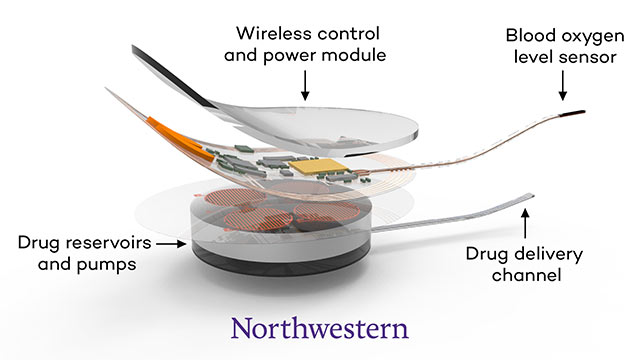Researchers are developing a novel, implantable device that can sense the effects of a potentially fatal level of ingested opioids and then automatically and immediately deliver a life-saving dose of naloxone.
The interdisciplinary research team, led by Northwestern University and Washington University at St. Louis, recently received a grant from the National Institutes of Health’s Helping to End Addiction Long-term (NIH HEAL) Initiative to accelerate its research.
The first phase of the program aims to develop and demonstrate the devices in animal models. The second phase, contingent on the first, will advance to the technology into a form suitable for use in humans. The full funding corresponds to $10 million over five years. Engineering development will occur at Northwestern, while in vivo testing will be performed at Washington University.

“Deaths from opioid overdose represent a human health crisis of epic proportions,” said Northwestern’s John A. Rogers, co-principal investigator on the project. “We envision an engineering-oriented approach to this crisis that exploits innovative bio-integrated electronic technologies.”
“When an opioid user goes through treatment or serves time in jail and does not use for several weeks, that person quickly loses the tolerance they have built up over years of opioid use,” said Dr. Robert Gereau, co-principal investigator on the project. “If that person then has a setback and uses again, that individual won’t be able to tolerate the same dose of the drug as before that period of abstinence. Such people are at high risk for overdose death — and even though naloxone is becoming more widely available, there isn’t always someone nearby to recognize the danger and administer the naloxone to rescue that person.”
Rogers is the Louis Simpson and Kimberly Querrey Professor of Materials Science and Engineering, Biomedical Engineering and Neurological Surgery in Northwestern’s McCormick School of Engineering and Feinberg School of Medicine. He also is the director of the Center for Bio-Integrated Electronics.
Gereau is the Dr. Seymour and Rose T. Brown Professor of Anesthesiology at Washington University School of Medicine.
More than 2 million Americans currently live with opioid use disorders and have a high risk of accidental overdose, which can cause severe, permanent lung damage or even death. The current opioid overdose treatment requires administration of an antidote, called naloxone, by a trained emergency responder.
We envision an engineering-oriented approach to the opioid crisis that exploits innovative bio-integrated electronic technologies.”
engineer
Although highly effective, naloxone administration faces several barriers: Another person must recognize symptoms of an overdose, and then contact emergency medical personnel with access to naloxone and the ability to administer it quickly and correctly. Tragically, overdoses most likely occur when the opioid user is alone or when naloxone delivery is too late.
Rogers’s and Gereau’s device would bypass all these barriers, as an automated form of emergency response and intervention. The complete system, which is about the size of a small USB thumb drive, can be implanted superficially, just beneath the skin, either in the abdomen, lower back or near the collar bone. Patients with a history of opioid use, who are at particularly high risk for overdose, could choose to have the implantation.
“These small, wireless implants support compact, sealed reservoirs filled with naloxone,” Rogers said. “A miniaturized, continuous sensor of tissue oxygenation identifies overdose episodes that lead to dangerously low oxygen supply, thereby automatically triggering the immediate release of a life-saving dose of naloxone — as an autonomous emergency response.”
About NIH HEAL
The NIH launched the HEAL Initiative in April 2018 to improve prevention and treatment strategies for opioid misuse and addiction and enhance pain management. The Initiative aims to improve treatments for chronic pain, curb the rates of opioid use disorder and overdose and achieve long-term recovery from opioid addiction. Northwestern and Washington University’s award is one of the 375 grants awarded across 41 states by the NIH in fiscal year 2019 to apply scientific solutions to the national opioid crisis.
“It’s clear that a multi-pronged scientific approach is needed to reduce the risks of opioids, accelerate development of effective non-opioid therapies for pain and provide more flexible and effective options for treating addiction to opioids,” said NIH director Dr. Francis S. Collins. “This unprecedented investment in the NIH HEAL Initiative demonstrates the commitment to reversing this devasting crisis.”


